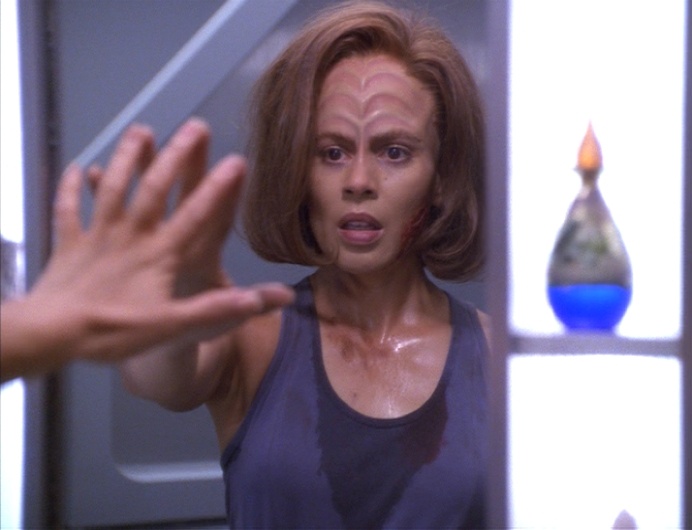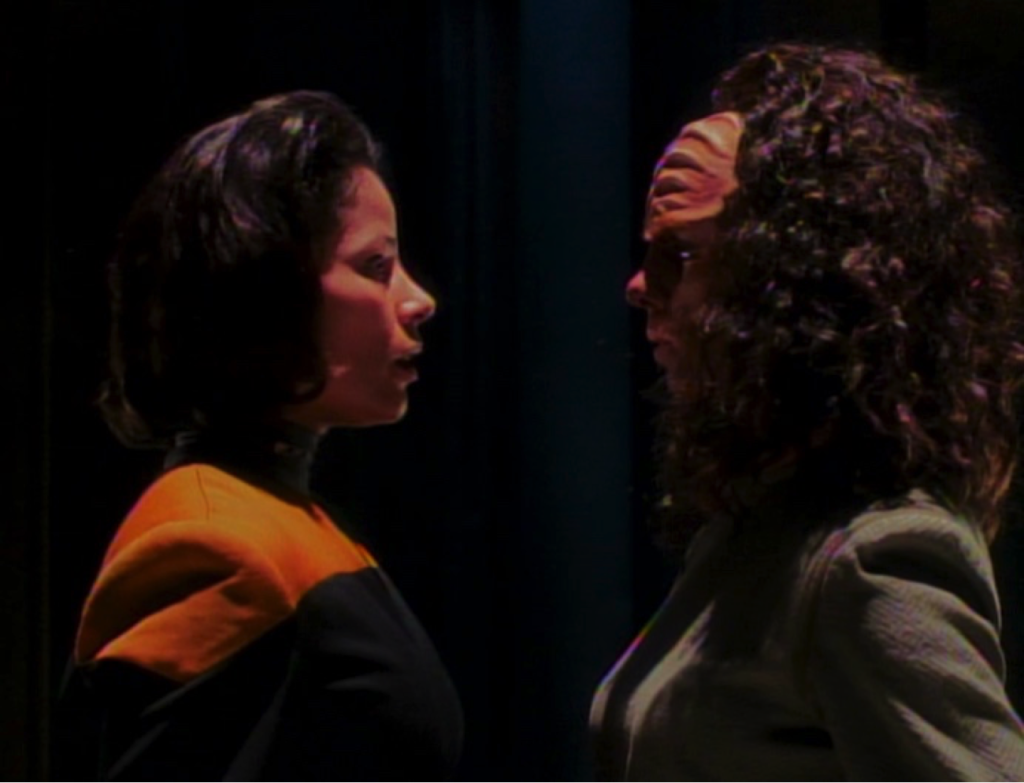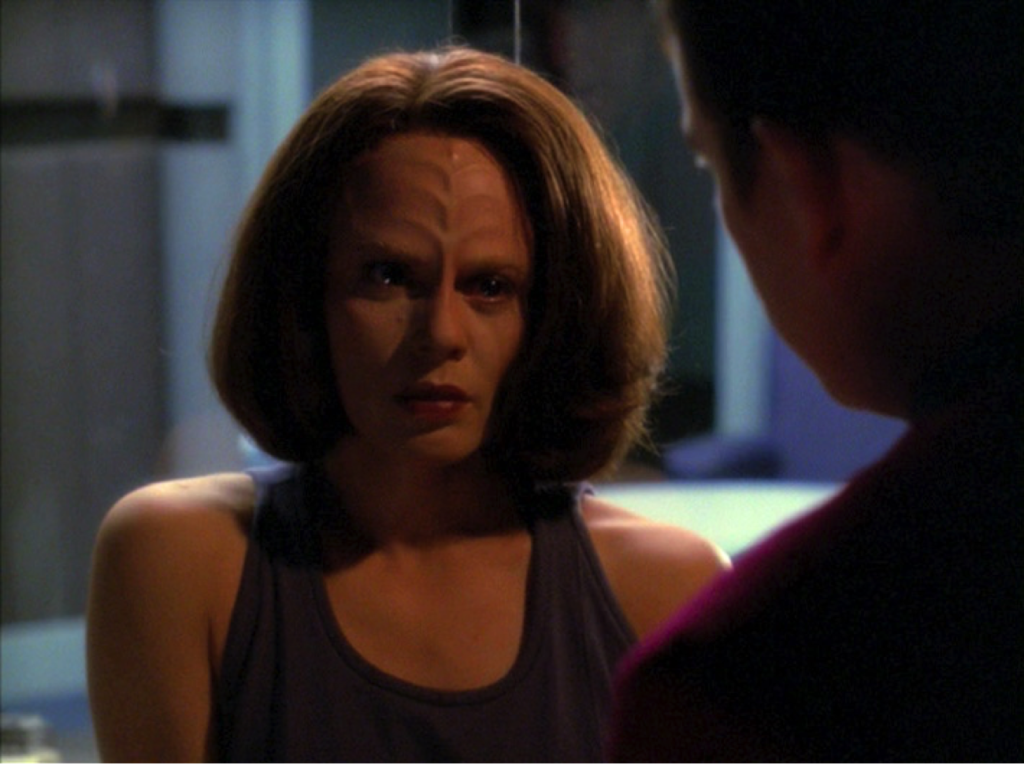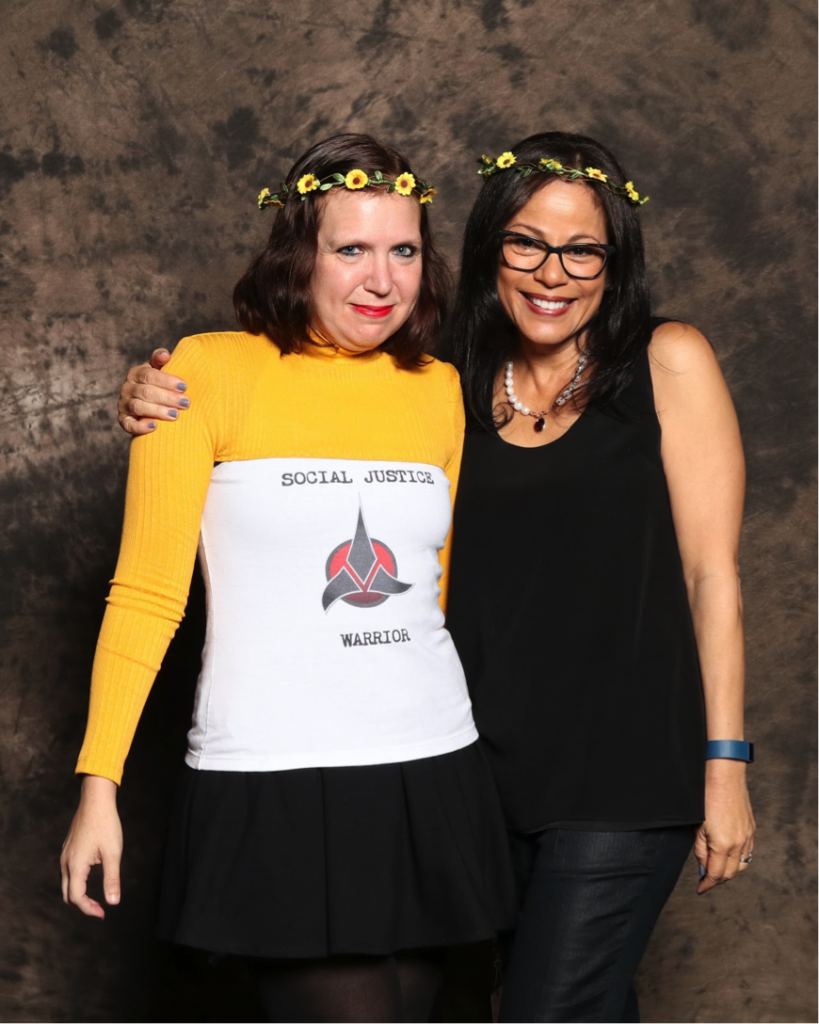
B’Elanna Torres snuck up on me. When Voyager began I instantly admired Captain Janeway, related to Kes, and crushed on Tom Paris, and when Seven of Nine was introduced she rapidly became my favorite character in all of Star Trek. Or so I thought.
When “Extreme Risk” first aired in Voyager’s fifth season it shook me. I loved Voyager, loved Star Trek, and I’d related to various characters and stories before, but this episode spoke to me on a deeply personal level. After learning of the death of her Maquis friends in the Alpha Quadrant, B’Elanna becomes depressed, isolates herself from everyone on Voyager, and reprograms the Holodeck to engage in self-harm. When confronted about her self-injurious behavior she tells Chakotay: “I’m not trying to kill myself. I’m trying to see if I’m still alive.” That was the moment B’Elanna became my favorite character, I just didn’t know it yet.
With the help of her friends and a well-timed engineering project, B’Elanna is able to work through her issues and start to heal. It’s somewhat unrealistically convenient and we never see or hear about her self-injuring after, or before, this. For a long time my annoyance at what I considered a too easy resolution kept me from fully embracing the episode, and B’Elanna, despite the emotional resonance.
But revisiting the series as an adult, and after dealing with my own depression and anxiety, I realized “Extreme Risk” is not a one-off and B’Elanna’s self-harm is not a situational quirk. B’Elanna Torres struggles with mental illness throughout the run of the series.

In the first season episode “Faces”, B’Elanna is split into two separate beings — one fully Klingon and one fully Human — as part of an alien medical experiment. In simplest terms the two B’Elannas embody either side of the fight-or-flight response: Klingon B’Elanna attacks problems, and people, directly while Human B’Elanna cowers both physically and within herself. I consider this an important introduction to B’Elanna’s anxiety disorder, and her coping mechanisms. When she has a scientific riddle to focus on she is able to stave off fear, and, though often over internal protest, she leans on her Klingon side, literally here and figuratively outside of this situation, for the inner strength her mother taught her to rely on as a child. B’Elanna is shown doing both as early as the pilot and as late as the finale.
B’Elanna gains confidence in her abilities as a direct result of her status as Chief Engineer and over the course of the series she bonds with the senior staff, finds true friends, and builds a family. She falls into depression and self-injury in “Extreme Risk” because the security and stability she’d finally found on Voyager was threatened by the news that the last group she’d thought she belonged with was not just lost, but destroyed. The events of the episode are entirely in character and what’s wonderful is how her Voyager family comes together to get her through it.

In the seventh season episode “Lineage,” B’Elanna’s pregnancy, and the revelation her daughter will have the same Klingon facial ridges she does, bring up memories of her human father’s abandonment, which throw her back into a state of high anxiety. She argues with her loved ones, hides her real fears, and again tampers with the computer, putting herself, and her unborn child, at risk. The episode proves that B’Elanna’s issues haven’t disappeared. In fact they’re pretty close to the surface. But it also proves, again, that B’Elanna doesn’t have to battle her demons alone. In Voyager’s crew she has a network of people to help, love, and support her. “Faces” and “Lineage” are bookends to B’Elanna’s story, and two of my favorite episodes of all time.
 The author with Roxann Dawson
The author with Roxann Dawson
Mental illness doesn’t go away. It can’t be “cured.” But it can be managed. B’Elanna taught me that mental illness isn’t a weakness any more than Human DNA is. She taught me to accept my flaws and to embrace my Klingon side. And Voyager taught me I don’t have to go it alone.
I never thought I would relate with just a single sentence as much as your very first one. For me, too, B’Elanna snuck up on me. I’ve always liked her, but as a teen I absolutely admired Cpt. Janeway (heck, I did school projects on her), being a scientist and feminist myself and all. This faded a little bit in my 20s, I still love Janeway, but I more and more felt increasingly connected to B’Elanna. I never really realized, why, but I just could relate with her so much more somehow. I’ve recently been diagnosed with both anxiety and PTSD, both of which I’ve been struggling with for over 15 years, I just never knew it. And like B’Elanna, I too struggle with not feeling like I belong and with identity. Ironically, “Extreme Risks” was my first ever Star Trek episode, the one that incited my love for Star Trek in general and Star Trek Voyager in particular. “Faces”, too, has always been a favorite of mine ever since I first saw it. Just as B’Elanna, science, work, has been and is my major coping mechanism.
Thank you so much for this post, over which I stumbled completely by chance and which manages to put my own feelings and thoughts towards B’Elanna perfectly into words.
I honestly found Lineage deeply disturbing, and not in a good way. Star Trek has always had a problem with casual racism among Starfleet officers, but in this episode it was especially noticeable.
In the flashbacks, we see B’Elanna’s family making fun of her for being Klingon. This is shown to be bad, it really hurts her and makes her feel unsafe. Then in the future, her Star Fleet crewmates also make fun of her for being Klingon, and this is treated as good wholesome fun.
B’Elanna is my favorite character in all of Star Trek for most of the reasons you listed. I think she is vastly under appreciated because of everything you said and more. She always seemed the most relatable in trek.
Thank you for sharing this! When I was young I remember her character bothering me. As an adult she didn’t, but you’ve made me realize that I was likely bothered because I recognized my own anxiety issues within her. You’ve really touched on why she’s so important.
I think this is a great piece. Personally I had depression and anxiety issues myself due to bullying in my childhood from when I was nine until a few months ago (just turned 23) but only got help the last couple of years. I pushed myself really hard with painful stretches for dance, and worked myself until I was drenched and exhausted. Team sports I played like I didn’t care about hurting myself. At my last job, the support I received was amazing even though I crossed the line a few times. Everything you say resonates with me.
Thank you for these lovely comments! I’m so honored the W@W crew gave me the opportunity to share it.
I love this post! Great analysis of B’Elanna’s arc. And nice flower crown 🙂 Thanks for sharing your story.
Yes! It sounds like we have the same relationship with B’Elanna. I immediately loved Janeway and Seven as soon as they came on screen, and I never disliked B’Elanna’s character, but I didn’t entirely *get it* somehow until Extreme Risk. After which I was hooked, and in my second (and third, and fourth, and…) VOY rewatches I’ve noticed more and more about her personality and her story arc that makes me love her more.
Great post, love the way you tied in her whole history. It gives that episode even more resonance. So well done.
Great first post! B’Elanna has also been my favorite character for a long time. I try to reconcile my queer and religious identities the same way she tried to do with Klingon/human.